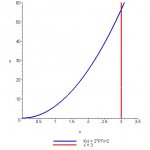I am not sure how to do these two problems:
1. The volume of a solid is obtained by revolving a region in the first quadrant of the xy-plane about the x-axis. The resulting integral is IN, limits 0 and 3, 2 pi x[sup:4hrw3q8b]2[/sup:4hrw3q8b] dx. Graph the region being rotated.
2. The graph of y = f(x) passes through the origin. The arc length from (0,0) to (x, f(x)) is s(x) = IN, limits 0 and x, = sq. rt. of 1+e[sup:4hrw3q8b]t[/sup:4hrw3q8b]dt. Determine the function f(x).
1. The volume of a solid is obtained by revolving a region in the first quadrant of the xy-plane about the x-axis. The resulting integral is IN, limits 0 and 3, 2 pi x[sup:4hrw3q8b]2[/sup:4hrw3q8b] dx. Graph the region being rotated.
2. The graph of y = f(x) passes through the origin. The arc length from (0,0) to (x, f(x)) is s(x) = IN, limits 0 and x, = sq. rt. of 1+e[sup:4hrw3q8b]t[/sup:4hrw3q8b]dt. Determine the function f(x).

